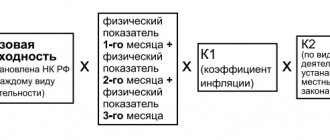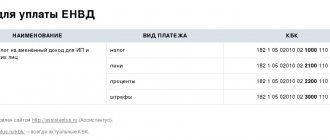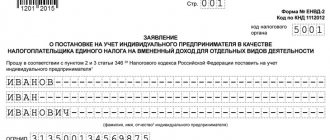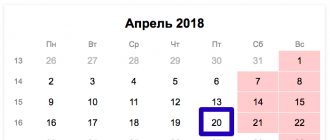What is K1 for UTII
K1 is the so-called deflator coefficient, which the federal authorities regularly review in order to record changes in consumer prices when calculating tax on imputed income. Every year, the K1 deflator coefficient for UTII is calculated and then published by the Ministry of Economic Development of the Russian Federation. The deadline for new indicators to appear is November 20.
IMPORTANT!
The K1 indicator is established by federal legislation, therefore, the same value is used in all regions. But K2 is a regional coefficient. This means that in the Moscow, Sverdlovsk or Chelyabinsk regions the values will be different.
K1 coefficient - what is it?
The procedure for calculating the tax payable under UTII is made special by the procedure for calculating the tax base. This base does not depend on the income actually received during the reporting period, but is determined by the profitability of the physical indicator characterizing each type of activity, the use of which is available under UTII.
The types of physical indicators (their list includes the number of employees, property and its parts used in the activity, the size of the area) for different types of activity may coincide, but the coincidence of the valuation will not be necessary. The ratio of types of activities with the physical indicators characterizing them and the amount of profitability per 1 unit of indicator per month is given in paragraph 3 of Art. 346.29 Tax Code of the Russian Federation.
However, it will not be possible to obtain the tax base by simply multiplying the number of physical indicators available to the taxpayer (legal entity or individual entrepreneur) by the amount of profitability, since clause 4 of Art. 346.29 of the Tax Code of the Russian Federation requires the application of two coefficients to profitability, designated as K1 and K2.
They characterize the conditions in which activities are carried out (Article 346.27 of the Tax Code of the Russian Federation):
- the first (K1), established at the federal level, is equal to the deflator coefficient and reflects changes in consumer prices;
- the second (K2), introduced in the constituent entities of the Russian Federation, characterizes the conditions for the implementation of each type of activity in a particular region.
How K1 changed
Order of the Ministry of Economic Development dated October 21, 2019 No. 684 will help you find out what the UTII K1 2021 coefficient is set. Officials approved a deflator coefficient of 2.009 for entrepreneurs on the “imputed” basis.
Let us recall that this taxation regime in Russia appeared in 2013, and since that time the authorities have been revising the values of increasing coefficients. See how K1 for UTII changed for 2020 and previous years.
| Period | K1 value | Basis (details of orders of the Ministry of Economic Development of the Russian Federation) |
| 2020 | 2,009 | From 10/21/2019 No. 684 |
| 2019 | 1,915 | From 10/30/2018 No. 595 |
| 2018 | 1,868 | From October 30, 2017 No. 579 |
| 2017 | 1,798 | From 03.11.2016 No. 698 |
| 2016 | 1,798 | From 11/18/2015 No. 854 |
| 2015 | 1,798 | From October 29, 2014 No. 685 |
| 2014 | 1,672 | From 07.11.2013 No. 652 |
| 2013 | 1,569 | From 10/31/2012 No. 707 |
Individual entrepreneur on UTII without employees
For example, let’s take an individual entrepreneur without employees, carrying out activities such as providing household services to the population, car repairs and retail trade.
K2 has different meanings in different localities. For example, we will take K2 for household services = 0.5; by car service = 1; for retail trade on an area of 40 sq. m = 0.8.
| Kind of activity | Year | Domestic services | Auto repair | Retail |
| Basic yield | 2019/2020 | 7 500 | 12 000 | 1 800 |
| Physical indicator | 2019/2020 | 1 | 1 | 40 |
| K1 | 2019 | 1,915 | ||
| 2020 | 2,009 | |||
| K2 | 2019/2020 | 0,5 | 1 | 0,8 |
| Fixed fees per quarter | 2019 | 9 060 | ||
| 2020 | 10 218 | |||
| Fixed contributions for income over 300 thousand (1/4 of the annual amount) | 2019 | 0 | 0 | 2 559 |
| 2020 | 0 | 0 | 2 722 | |
| UTII before reduction by contributions | 2019 | 3 232 | 10 341 | 49 637 |
| 2020 | 3 390 | 10 849 | 52 073 | |
| Total UTII payable | 2019 | 0 | 1 281 | 38 018 |
| 2020 | 0 | 631 | 39 133 | |
| Change of UTII | rub. | — | -650 | 1 115 |
| % | — | -51 % | 2,9 % | |
| Change in the total tax burden (UTII contributions) | rub. | 1 158 | 508 | 1 273 |
| % | 12,8 % | 4,9 % | 2,7 % | |
Conclusion: for those single individual entrepreneurs whose tax was more than covered by fixed contributions in 2021, it will remain at zero in 2020. For some, the tax will even decrease, since with an insignificant increase in UTII due to an increase in K1, there is a simultaneous increase in insurance premiums, which reduce the amount of the increased tax, making it even less than it was in the previous year.
However, even with a decrease in UTII, the overall tax burden on entrepreneurs will increase , since fixed contributions in 2021 will increase by almost 13% compared to the current size.
That is, for individual entrepreneurs in this case, the increase in fixed contributions is felt much more strongly than the increase in K1.
Source:
"Clerk"
Heading:
UTII
UTII deflator coefficient tax increase small business
- Inna Kosnova, Clerk columnist, accounting and taxation expert
Sign up 8645
12350 ₽
–30%
Why does the coefficient affect the tax amount?
To calculate the tax base according to “imputation”, the following formula has been introduced:
NB = BD × K1 × K2 × (FP1 + FP2 + FP3),
Where:
- NB is an abbreviation of the phrase “tax base”;
- BD - basic profitability established at the federal level;
- K1 and K2 are adjustment coefficients that can be changed by federal and regional authorities;
- FP1, FP2 and FP3 are physical indicators registered by the taxpayer when carrying out activities in each month of the quarter (area, number of employees or vehicles).
It is clear from the formula that K1 in 2021 according to UTII plays a big role in the formula: the higher this indicator, the more entrepreneurs and organizations pay, even if other business parameters remain the same.
Deflator coefficient for UTII
The coefficient under consideration is usually denoted by the alphanumeric code K1. Its economic significance is the determination of changes (increases) in prices for goods or services on the Russian market in the previous period. Using this coefficient, the expected profitability of a particular business included in the list of acceptable types of activities for the special UTII regime is established (clause 2 of Article 346.26 of the Tax Code).
The tax base for UTII is adjusted by the amount K1 (Article 346.29 of the Tax Code). Its size for the calendar year is set by the Ministry of Economic Development of the Russian Federation. The new value of the parameter, accepted in tax calculations from the beginning of 2021, was approved by departmental order No. 595 of October 30, 2018.
The formula for calculating the single imputed tax is the product of the tax rate by the multiplied values of the basic profitability, physical indicator, coefficients K1 and the reducing coefficient K2 established in a specific region:
UTII = Estimated (basic) profitability (BD) x Physical indicator (FP) x K1 x K2 x Tax rate (SN).
The amount of imputed income for an incomplete quarter (for example, when registering or deregistering in the middle of the period) is calculated for the time the individual entrepreneur or company is actually in the special UTII regime. In this case, the estimated income is calculated using the formula:
VD = BD x FP x K1 x K2 / D x RD,
where D is the number of calendar days in a month,
RD – the number of days in a month in which activities were carried out under the UTII regime.
The value of K1 for 2021 and its reflection in the reporting
Changes in the value of consumer prices, as a rule, are expressed in their growth, since prices directly depend on inflation processes. Therefore, the value of the deflator coefficient is steadily increasing.
For 2021, for the purposes of calculating the imputed tax base, it is determined in the amount of 2.009 (Order of the Ministry of Economic Development of Russia dated October 21, 2019 No. 684), i.e., increased by 4.9% compared to the coefficient set for 2021 (1.915). For both categories of taxpayers (legal entities and individual entrepreneurs), the value of the deflator coefficient will be the same.
As a mandatory component of the calculation of the tax base, the K1 coefficient is reflected in the tax reporting (declaration) generated quarterly in relation to UTII. It will have to be shown on all sheets included in Section 2, on line 050: next to the return value of the physical indicator (line 040) and the value of the K2 coefficient (line 060).
What is the deflator coefficient used for?
In the simplified tax system:
To determine the maximum income value at which you can switch to the simplified tax system. In 2021, the amount is set at 45 million rubles. If the organization’s income in the previous period was less than 45 million rubles, then it has the right to switch to a simplified taxation regime.
To determine the maximum amount of income at which the simplified tax system cannot be applied. In 2021, the amount is set at 60 million rubles. If the income of an organization using a simplified taxation system in the previous period exceeded 60 million rubles, it will have to switch to another taxation regime.
In UTII:
To calculate the tax base for a single imputed income. The calculation is made using a special formula that takes into account both the K1 and K2 coefficients.
In PSN:
To calculate the maximum amount of potential income of an entrepreneur, taking into account which the possibility of applying this taxation regime remains.
The basic value of the maximum potential income under PSN is set at 1 million rubles. To calculate this value for the current year, it is necessary to multiply it by the deflator coefficient. For example, in 2015, this coefficient had a value of 1.147. This means that the maximum potential income for PSN entrepreneurs was 1,147,000 rubles. Entrepreneurs whose income exceeds this amount cannot continue to apply the patent tax system in the current period.
In property tax calculations:
To determine the inventory value of a taxable object. For example, in the last period the cost of the object was estimated at 300,000 rubles. But in the current period, taking into account inflation, there is a need to recalculate property taxes. A deflator coefficient is used to calculate the new value.
In calculating personal income tax in relation to foreigners:
To determine the amount of tax on income from activities based on the received patent. The fact is that foreigners who want to work for individuals who are Russian citizens must obtain an appropriate patent and pay tax on their income. The activities of a foreigner should not be of an entrepreneurial nature. Foreigners have the right to provide services and carry out labor activities only for hire and only to individuals. According to Russian law, such citizens are required to make monthly advance payments to the treasury of our state in the amount of 1,200 rubles. Every year this amount is indexed taking into account the established deflator coefficient.
In calculating the trade fee:
To establish a fee rate for persons engaged in organizing retail markets. The fixed rate at the federal level is 550 rubles per sq. m. meter. The deflator coefficient allows you to annually index this value and increase the trading fee from entrepreneurs.
Correction coefficient-deflator K2
The deflator coefficient K2 is used in calculating the tax base for UTII together with the coefficient K1. It is used to adjust the amount of the tax base taking into account various factors that affect the income of entrepreneurs in a particular area of business.
For example, factors affecting income may include:
- seasonality;
- type of product;
- characteristics of the place of activity;
- area of information fields of advertising products;
- the number of vehicles used;
- income levels.
The K2 coefficient is designed to improve the conditions for doing business by reducing the tax base.
It is established by regional authorities and can have different meanings for different types of business activities. By federal legislation, regional authorities are authorized to determine and establish specific values for the K2 coefficient, taking into account the specified lower and higher limit values (the coefficient cannot be lower than 0.05 and higher than 1).
Also, the local government has the right to change the values of the coefficients at its discretion. Despite these powers, in practice the adjustment coefficient K2 most often remains unchanged, and sometimes changes downwards. This allows entrepreneurs to reduce their tax base to some extent or keep it at a more or less stable level.
How is the K2 coefficient used in calculating UTII?
To calculate the tax base for UTII, the following formula is used:
UTII = BD * FP * K1 * K2 * 15%,
where BD is the basic profitability (legislation establishes a single value for the entire territory of the Russian Federation);
FP – physical indicator;
K1 and K2 – deflator coefficients;
15% – tax rate for UTII.
As can be seen from the formula, a decrease in the value of the K2 coefficient leads to a decrease in the tax base for UTII.
How to find out the K2 coefficient in your region
- To find out the value of the K2 correction factor in a certain region, it is best to contact the territorial tax office and obtain the information of interest.
- You can study local regulations in search of the K2 value, which will be more labor-intensive and time-consuming.
- The value of the K2 coefficient can be found online on the website of the Federal Tax Service.
To do this, you need to take the following steps:
- Follow the link https://www.nalog.ru;
- Scroll down the page
- Next, in the horizontal menu, find the “Taxation in the Russian Federation” tab and select the first item “Taxes and fees in force in the Russian Federation.”
- Scroll down the page, find the section “Special tax regimes” and select UTII.
- Next, to find out the value of K2, you need to use a tax calculator. To do this, scroll to the bottom of the page and find the section “Features of regional legislation.” The region can be selected on the right, but most often it is determined automatically. You need to find the “Go” button and click on it. Next, in the new window, click again on the “Go to UTII calculation” button.
- In the future, you need to enter the data and select the necessary items. Actions are intuitive. At the final stage of calculations, you can see the K2 value for a specific type of business activity in your region.
Tax calculation formula and deflator coefficient K1 for UTII 2020
The purpose of the K1 coefficient is to adjust the tax base for calculating the “imputed” tax for types of activities to which the special regime applies. The size of K1 is determined by the level of growth in prices for goods (services) in the previous period.
The single tax on “imputation” is calculated using the following formula:
UTII = BD x K1 xK2 x (FP1 + FP2 + FP3) x Tax rate,
where BD is the basic profitability determined for each type of “imputed” activity (in paragraph 3 of Article 346.29 of the Tax Code of the Russian Federation);
FP – the value of the corresponding physical indicator (number of employees, number of trucks, area of the sales floor, parking lot, etc.). FP is taken into account for each month of the tax period (FP1, FP2, FP3), and if in any month its value has changed, the change is taken into account from the beginning of such month (clause 9 of Article 346.29 of the Tax Code of the Russian Federation);
K2 is a reduction factor established by regional laws in the range from 0.005 to 1. It can consist of several values, multiplied together, and differentiated by type of activity, categories of taxpayers, etc.
The K1 deflator for “imputation” is established annually by order of the Ministry of Economic Development of the Russian Federation and is valid for all regions where a special regime has been introduced. The K1 coefficient for UTII for 2021 was approved by Order No. 684 of October 21, 2019 in the amount of 2.009. But today a draft amendment to the document is already being considered, proposing to reduce this value of K1 to 2.005.
For comparison: the K1 UTII coefficient in 2021 is 1.915. Its new value (with a constant K2 value) will lead to an increase in the tax burden in 2021 by approximately 4.9%, and if the K1 size is reduced to 2.005 - by 4.7%.
Let's look at examples of how the 2020 K1 coefficient will affect the tax amount when calculating UTII.






